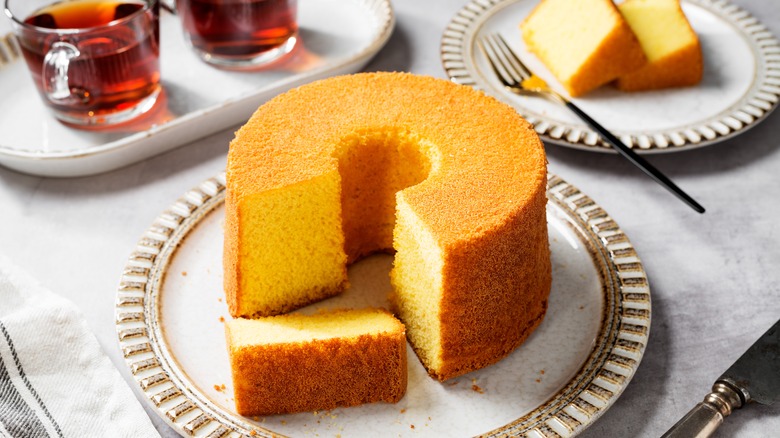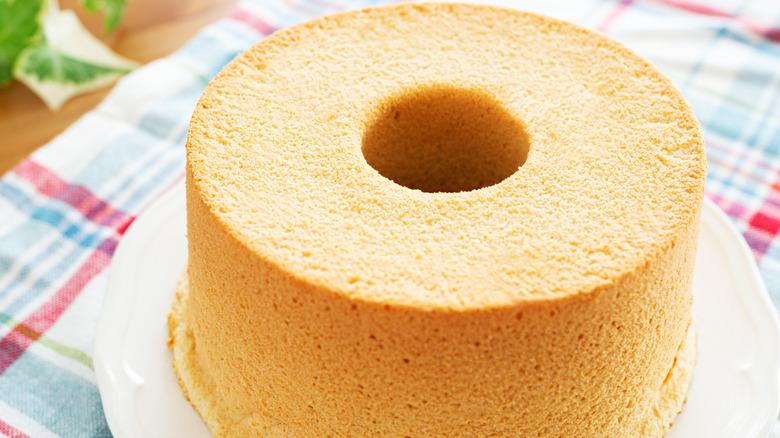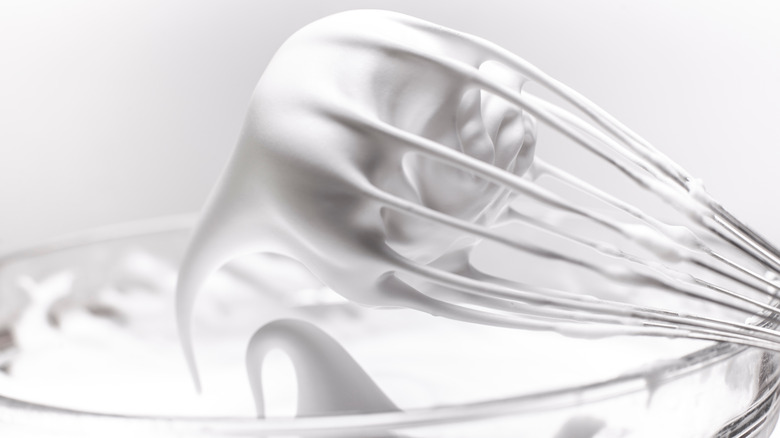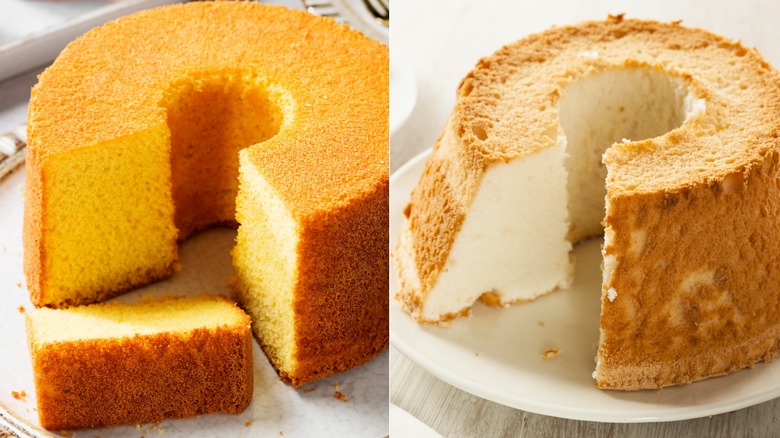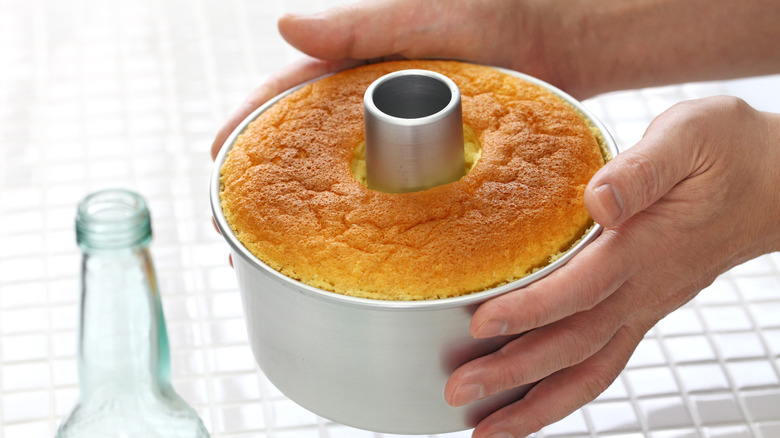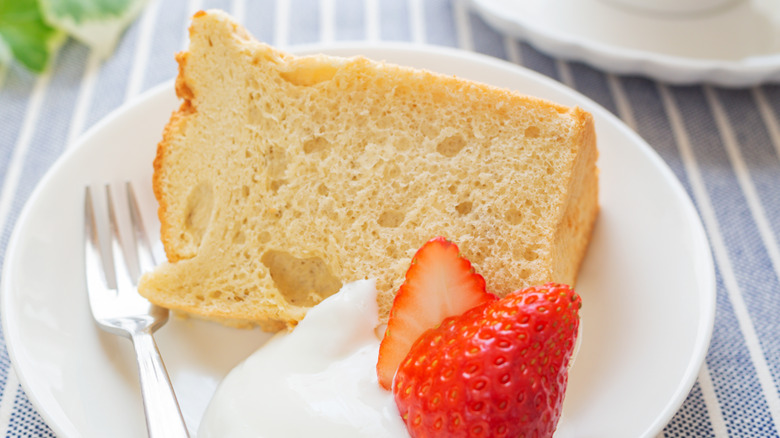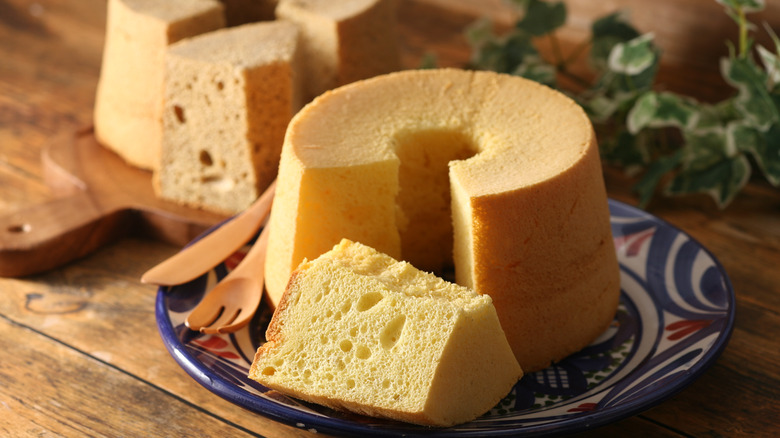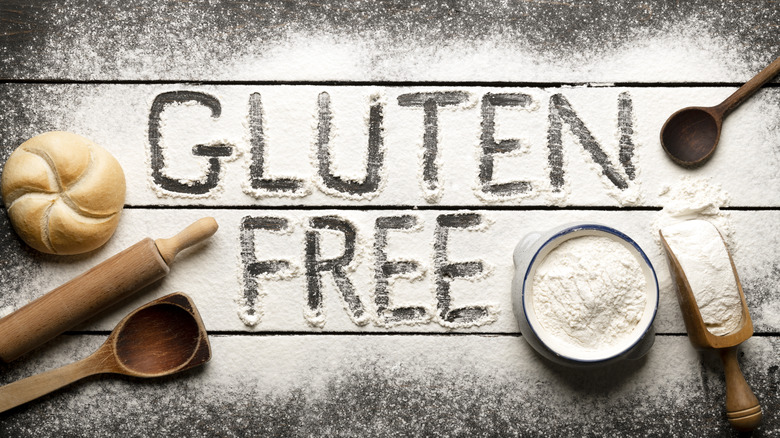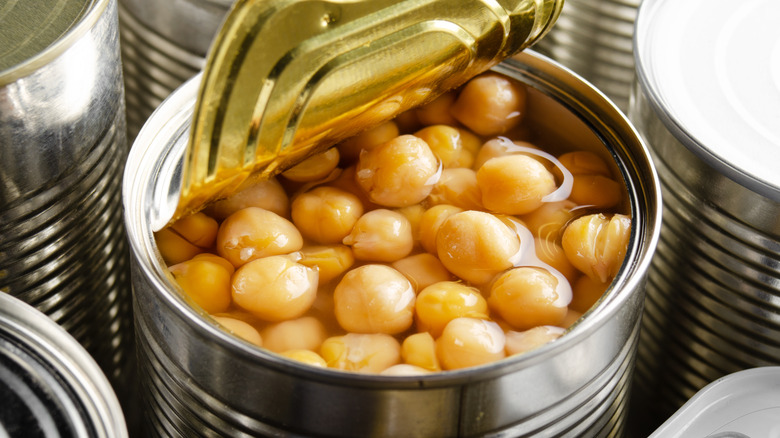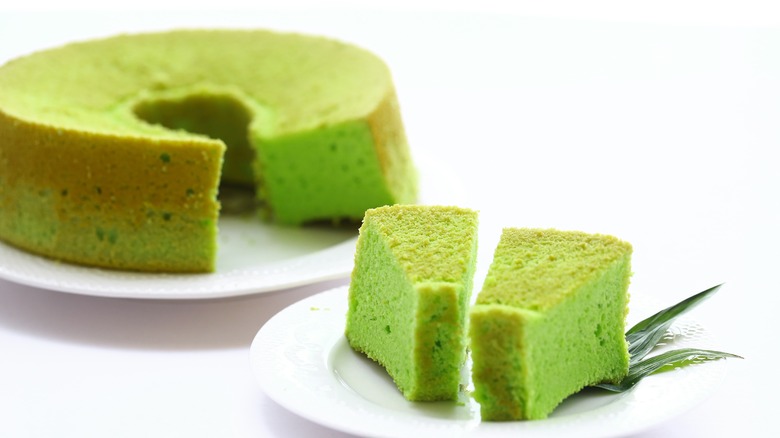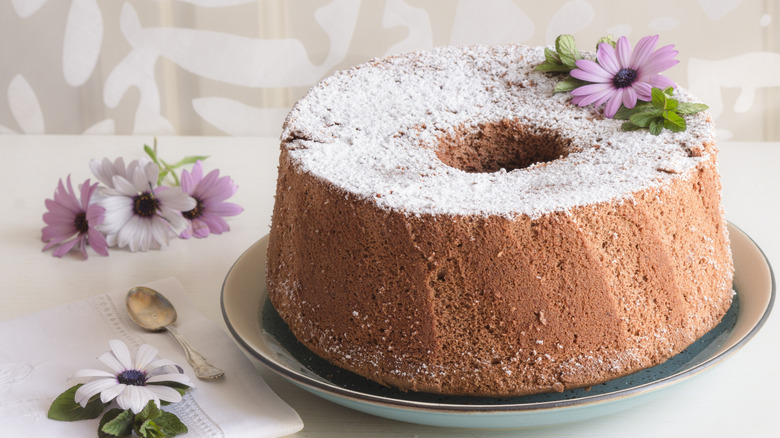The Ultimate Guide To Chiffon Cake
Chiffon cake is a delicate dessert that is so light and fluffy that it's often described as having a cloud-like texture. Usually baked in a tube pan, this round, tall cake looks stunning on display and is a versatile dessert that can be enjoyed all on its own with tea or coffee. It also serves as a sweet, but not overpowering, base that tastes amazing when topped with icing or fruit or dished out with pudding or powdered sugar. The pale-colored cake is usually yellow or cream-colored inside with a spongy texture, whereas the exterior is typically slightly browned to form a very thin crust. Once removed from the tube pan, the cake is often so fragile that it has little movement to it. It is best served as a large thick slice to enjoy.
Not to be confused with angel food cake, chiffon cake has a similar texture and taste but is made with different ingredients. To master this recipe, you'll need separated eggs, white flour, vegetable oil, sugar, cream of tartar, and a few others that vary depending on the recipe. Although this popular dessert originated in the United States, it's now enjoyed all over the world and is known as a sweet, light, and fun dessert. Check out this guide to understanding everything about chiffon cake from where it originated to cooking tips, and how to freeze and serve this delicacy.
Chiffon cake was invented by Harry Baker
Just the name chiffon was enough to pique interest back in 1927, thanks to the image that the word brings to mind. Thin gossamer, sheer fabric that is almost as light as air and usually used to make lingerie is what Harry Baker decided to call his cloud-like cake and it paid off. A man who formerly sold insurance upended his life in Ohio and moved to Los Angeles. Once there, he began experimenting with cake recipes, trying endless combinations and ingredients before landing on one that used vegetable oil rather than butter to create an airy inside.
Once the recipe was perfected, Baker kept it close to his heart, refusing to disclose the secret ingredient. Baker began selling his cakes to the original Brown Derby restaurant on Wilshire Boulevard and later expanded to other restaurants that were a hotspot for Hollywood movie stars. Gaining popularity, Baker continued baking right in his apartment to meet the newfound demand for his cakes. He kept the secret recipe for his beloved chiffon cake for nearly 20 years before he was tempted to sell.
Chiffon cake was sold to General Mills
After 20 years of success and secrecy, Harry Baker eventually relinquished his crowning achievement. However, unsurprisingly, the baker never revealed how much he received for selling his chiffon cake recipe. General Mills acquired the closely guarded recipe and immediately set to work promoting it. The buyers were advertising it as one of the first truly new cake recipes to hit the market in something like 100 years. The intrigue of a new dessert (sold for a secret fortune) along with the rich, sweet flavor and a light, airy texture quickly made chiffon cake a new favorite.
The recipe swapped out butter for vegetable oil and called for the egg whites to be whipped into stiff peaks, which created a cake that had hundreds of tiny holes and practically melted in your mouth. As soon as the recipe became available, it was an instant classic. For those who wanted to get creative with the cake, they turned to zesty orange and lemon versions, which took the baking scene by storm. By adding orange or lemon zest, some juice, and even some acidic glazes, the cake was the perfect addition to parties, dinners, and other gatherings. After that, the cake was difficult to improve upon because it was already so delightful. General Mills recognized that the cake was rich, thanks to the egg yolks, and not too sweet, making it a must-have, or a must-make in homes around the country.
The secret to baking a chiffon cake
The amazing thing about chiffon cake is the ease and simplicity of the recipe. In fact, when the cake was all the rage back in the '50s and '60s, Generals Mills was tempted to capitalize on its success by creating a boxed mix. However, the cake was already so easy to make that it was hardly necessary, but there are a few notable tricks to making a truly outstanding chiffon cake from scratch.
First, it's important to use vegetable oil, rather than butter. This difference is what really sets the cake apart. Secondly, the eggs. It's likely that the most difficult part of whipping up a chiffon cake is the eggs. You'll need to very carefully separate the egg whites from the yolks. Even a small amount of yolk can prevent the whites from stiffening properly. Whip the whites into stiff peaks that stand tall and curve slightly at the top when you lift the beater out of the bowl. This will ensure that unforgettable light texture.
In addition, some recipes call for cake flour rather than all-purpose. This can also help achieve the fluffy inside that is so enjoyable. Finally, allow the cake to cool upside down. The cake is delicate, which means if you let it sit on your counter in a tube pan while it cools, it could flatten and lose its airiness. Cool your cake upside down in an ungreased tube pan for the best results.
Chiffon cake versus angel food cake and sponge cake
Chiffon cake made such waves in the culinary world for its outstanding light texture. However, there are similar recipes for angel food cake and sponge cake which, at first glance, appear to have a comparable texture, taste, and appearance. But, they all have their own special qualities and each recipe is slightly different, deserving its own recognition.
For example, angel food cake has a springiness to it that is reminiscent of a chiffon cake, yet once you cut it open you'll really notice the difference. Chiffon cake is often a buttery yellow color on the inside because of the egg yolks, but as angel food cake only calls for egg whites, the center is a crisp white color that looks very high-end when displayed on a cake dish. Another competing dessert is sponge cake. The springy texture and mild flavor can be served in similar fashions to its cousins — chiffon and angel food cake — yet this particular type of cake is extra absorbent. Sponge cake is excellent if you plan to serve it with syrups or other liquids to sweeten the dish and its texture comes from the air ttrapped during the process of beating the eggs. Although all three cakes have mild differences they are often considered interchangeable in the dessert world.
The tube pan is important
Most chiffon cakes are baked in a ring-shaped pan that has a hole in the center known as a tube pan or sometimes a bundt pan, though there is a difference. This pan has a technical design that perfectly cooks a chiffon cake, but they are best baked in a tube pan. Bundt pans are more often rounded at the top and have intricate designs embellished into the sides. These produce unforgettable-looking cakes but the delicate batter of chiffon cake can stick to the sides and make it difficult to remove. A helpful tip is that you can make your own tube pan by placing an oven-safe ramekin in the center of a springform pan.
Bundt pans were actually invented about 20 years after chiffon cake, whereas tube pans likely date back to the 1890s. The tube down the center and the removable bottom help delicate cakes cook evenly, and rise properly, especially through the center where they tend to deflate because of the lack of flour and gluten to keep their shape. Tube pans are also recognizable by the legs on the top and the removable bottom. This simple pan was actually intricately designed for cooking and cooling these cakes. Another trick is to avoid greasing the tube pan. If the batter cannot stick to the sides as it cooks it will fall flat. After it's cooled you can easily use a knife to cut the cake away from the edges.
How to serve chiffon cake
The sweet but mild flavor of chiffon cakes makes the airy dessert a versatile base for creativity. The fluffy interior will pair well with a long list of ingredients and the soft cake is absorbent, which means a delicious dessert is almost a guarantee. If you're looking for a simple but refreshing summer sweet, consider using chiffon as a version of strawberry shortcake. Add a layer of whipped cream either on top or covering the cake and then pile on the fresh strawberries. Garnish with fresh mint for an unforgettable finishing touch. If you have more time, you can use a serrated knife to cut the cake into two layers. Pile on cream cheese frosting, vanilla pudding, or more sliced fruit inside to make a layer cake.
Chiffon cake looks fantastic on a cake dish all on its own, but consider sprinkling confectioner's sugar for a more finished look. You can mix powdered sugar, a squeeze of lemon juice, and a bit of zest for a tart version that will only take minutes to whip up. The same goes for an orange version. The mild taste of chiffon cake goes great with different types of fresh, tart fruits. Consider adding a few blueberries and raspberries on top with Cool Whip for a festive summer treat. A large slice of plain chiffon cake is the perfect addition to your afternoon tea, or your morning coffee, and it just might be your new favorite snack.
How to make a dairy-free chiffon cake
If you're lactose intolerant or simply looking to cut back on dairy, you're in luck! Most chiffon cakes are already dairy-free and so do not call for milk, butter, or cream, which means you don't have to do any substituting or calculating to make a satisfying dairy-free dessert for you and your family. But, it's likely that dairy will be called for in the icing, pudding, or frosting that some use to decorate or fill chiffon cakes. Another tip is that cream of tartar is typically on the ingredient lists; however, don't be fooled, it does not contain any dairy or animal products.
The great news is that there are also plenty of ways to toppings and fillings without dairy. Rather than using whipped cream for the top of your Chiffon cake, swap it out for a coconut cream
version. You can make this easily in your home with a can of coconut milk and a blender. Or there are dairy-free products that you can buy premade. When using pudding to fill the layers of your Chiffon cake you can still use boxed mixes. Replace the whole milk with a milk alternative, such as oat milk for a creamier texture or almond milk for a nuttier flavor. The switch to dairy-free living is easier than you think with these helpful tips.
How to freeze chiffon cake
Chiffon cake is so delectable that you likely won't have leftovers. If by chance it lasts for more than a day, there are ways to preserve the cake to enjoy later. Freezing chiffon cake is one method that allows you to store the dessert and prevent it from spoiling for about three months. A helpful tip is to slice the cake into sections, usually about two serving sizes is a good rule of thumb. Wrap the slices in plastic wrap and place them in an airtight freezer bag or in a container to help the cake keep its shape. You can thaw the cake in the fridge or on the counter to enjoy the cake as if it were fresh in a few hours. Freezing the cake and defrosting it, may cause it to lose some of the light fluffy texture, but the flavor will persevere.
Freezing chiffon cake without any toppings or fillings is an excellent way to always have dessert or a snack ready at all times. If your cake already has filling, freeze it in an airtight container and also allow it to thaw in the fridge to avoid the filling from melting or sliding off. However, this could be messy and you could lose the presentation aspect. If you don't want to freeze the cake, store it in the fridge in an airtight container for approximately five days. The oil in the cake will slow down the staling process.
How to make chiffon cake gluten-free
Most chiffon cake recipes call for cake flour or all-purpose flour. However, those are typically high in gluten, and more and more people are cutting back on this protein which is found in wheat and helps keep your baked goods from falling apart. Finding the right gluten-free recipe might take some trial and error, but here are a few tips for making your chiffon cake taste just as good without gluten.
Certain gluten-free recipes call for a mixture of various flours that each serve their own purpose in the baking process. Common replacement flours are tapioca flour, which has a very fine texture, and rice flour. These can help achieve a similar texture to regular chiffon cake: however, gluten-free baking can be a delicate balance that isn't always foolproof. These recipes also require potato starch or xanthan gum to help thicken the batter and hold it together, which can also require some patience. A simpler solution is to use one-to-one all-in-one gluten-free flour Oftentimes, these come with xanthan gum already mixed in, which means you don't have to add a stabilizer.
You can make an eggless chiffon cake
Chiffon cake is a delightful dessert and everyone deserves to enjoy it, even those who have egg allergies or stick to a vegan diet. Traditional recipes call for 5 to 7 eggs and they are partly responsible for the creamy yellow color and the texture. However, thankfully just a few short years ago an affordable and eggless substitute was discovered and has since changed the way vegan bakers make chiffon cake, meringues, and much more. The versatile substitute is called aquafaba. This ingredient is the resulting liquid after cooking legumes and beans, such as white beans or most commonly chickpeas. You can make aquafaba at home by cooking beans on the stovetop or simply save the liquid from a can of chickpeas, which tends to be a little thicker.
This amazing egg alternative can replace eggs when baking. Treat the aquafaba as you would egg whites in a chiffon cake recipe by whipping them with a beater/standing mixer until stiff peaks form. This can take a bit longer than egg whites, but adding a teaspoon of cream of tartar can speed up the process. To measure the correct amount, look at one egg as being 3 tablespoons of aquafaba. Two tablespoons can represent an egg white and one can take the place of an egg yolk. Consider storing the aquafaba in the fridge for a few hours before whipping, as it's often easier to get the desired consistency when after chilling.
Chiffon cake is popular in Asia
Pandan cake is Asia's version of chiffon cake and although the popularity of this dish faded somewhat in the United States since its creation, it continues to thrive overseas. One notable distinction between a pandan and the traditional chiffon cake is the bright green color. The floral/sweet aroma and taste also differ from the American version. This green cake is made with the same ingredients as chiffon cake, with the addition of long, tropical pandan leaves, that have a pleasant scent and are used frequently in Asian cuisine.
The vibrant color of the cake comes from blending the leaves with water, which are then strained, to leave behind a smooth green liquid that's added to the batter. Pandan cake has the same fluffy, airy texture as chiffon, thanks to the eggs and oil, and is prepared in a very similar way. And, it's customary in Asia to serve this cake during times of tradition and celebration, such as weddings, and religious gatherings.
Less common chiffon cake ideas
Chiffon cake is such a beautiful dessert when it's sprinkled with powdered sugar, set on a cake dish, and served alongside some freshly sliced fruit. However, there are always ways to get creative and push the dish to another level. Small-shaped cakes are one way to add an unexpected change-up. You can try, for example, smaller shaped ramekins or larger muffin tins that can work perfectly for tiny chiffon cakes, as the middle is less likely to fall in such a small pan. And, they look adorable!
In addition, the cake batter is already so light and fluffy that it's easy to make small additions without changing the consistency. For example, add a few tablespoons of cocoa powder to the batter and enjoy a chocolate chiffon cake. You can top this with a chocolate glaze and strawberries for a slightly different variation. Some even choose to gently fold fruit into the cake for a surprise center. Chiffon cake is a classic and the possibilities to spruce it up are endless!
